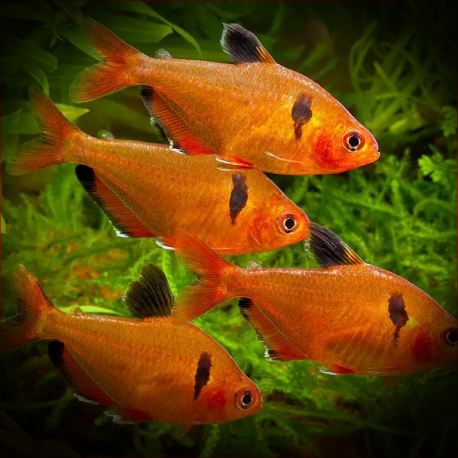Hyphessobrycon Eques
Characiformes Print
More info
Datasheet
| Minimum Tank Size | 96 litres / 25.36 US gallons |
| Maximum Size | 4.0cm / 1.57inches |
| Temperature | 20°C / 68.00°F - 28°C / 82.40°F |
| Hardness | 1.01dgH / 18ppm - 15.02dgH / 268ppm |
| pH | 5.0-7.5 |
Behaviour
Hyphessobrycon eques is known for its aggressive behavior in community tanks, often nipping the fins of tankmates, particularly when kept in insufficient numbers or limited space. The species is gregarious, forming loose hierarchies with males competing for female attention and establishing dominance within the group. It is recommended to keep a minimum of 12 specimens to lessen aggression and create a natural group dynamic. Males display enhanced coloration in the presence of rivals. However, due to its boisterous nature, it is not recommended to keep H. eques with shy, slow-moving, or long-finned fish. Compatible tankmates include robust species from similar biotopes, such as open water-dwelling characids, gasteropelecids, lebiasinids, smaller callichthyid or loricariid catfish, and some small-to-medium-sized cichlids.
Feeding and Diet
H. eques is likely omnivorous, feeding on small invertebrates, crustaceans, algae, fallen fruit, and other natural food sources. In aquariums, they can survive on a diet of dried foods but thrive when offered a varied menu that includes live and frozen foods like chironomid larvae (bloodworm), mosquito larvae, Daphnia, and Moina. Providing a diverse diet is essential for their overall health and well-being.
Reproduction & Dimorphism
The breeding behavior of H. eques involves egg scattering without parental care. In ideal conditions, adults will spawn frequently, and fry may appear in a mature aquarium. Controlled breeding setups can enhance fry yield, involving dimly lit, mature water-filled tanks with suitable spawning substrates like mesh, grass matting, or spawning mops. Female H. eques are larger and rounder-bodied compared to males, exhibiting sexual dimorphism.
Habitat and Distribution
Naturally, Hyphessobrycon eques inhabits still and sluggish tributaries, backwaters, ponds, and small lakes, where they form groups around marginal vegetation and submerged tree roots. The species has a widespread distribution across the Amazon drainage in Brazil, Peru, and Bolivia, as well as the Río Paraguay in Brazil, Paraguay, and Argentina. Wild populations exhibit variations in color patterns, fin shapes, and humeral spot characteristics depending on their origin.
Aquarium Setup
For H. eques, a well-furnished tank setup is recommended, including live plants, a dark substrate, wood roots, and branches to provide ample hiding places. Decor choice can influence their coloration and natural behavior. A natural-looking environment with soft sand, wood, and leaf litter can mimic their natural habitat and cater to their well-being. Maintaining appropriate water parameters, including pH levels between 5.0-7.5, temperature of 20-28°C, and hardness of 18-268 ppm, is crucial for their overall health and stress-free environment.

